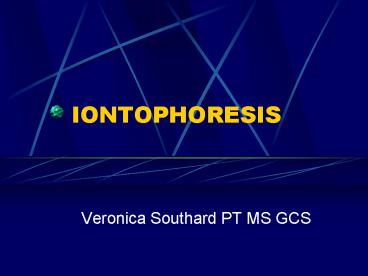IONTOPHORESIS - PowerPoint PPT Presentation
1 / 23
Title:
IONTOPHORESIS
Description:
Phonophoresis delivers whole molecules across the skin into the body. ... Hyperhidrosis. M spasm. Fungi open skin lesions. Herpes. Gout. Contraindications ... – PowerPoint PPT presentation
Number of Views:3265
Avg rating:3.0/5.0
Title: IONTOPHORESIS
1
IONTOPHORESIS
- Veronica Southard PT MS GCS
2
General Statements
- Indicated to introduce ions into the body using
direct current - Advantages are its painless, sterile, noninvasive
3
Difference between Ionto and Phono
- Phonophoresis delivers whole molecules across the
skin into the body. - Iontophoresis delivers ions into the tissues.
- Both are noninvasive means to delivers chemicals
to the body
4
Mechanisms of Ion Transfer
- Ionization requires soluble cmpds. I.e. acids,
alkaloid or salts that dissociate or dissolve
into ions, suspended in solution, creating
electrolytes. - Ions move/migrate in solution according to he
electrically charged currents - Electrophoresis- Def. - Movement of ions in
solution
5
Electron Concentration
- Cathode is the negative electrode that has a gt
concentration of electrons. The cathode is
negatively charged - The anode is positively charged and has a lt
concentration of electrons
6
Polarity
- Negatively charged electrons are repelled from
the cathode. Thus negatively charged electrons
move toward the positive pole where they create
an acid reaction. - Positively charged ions are attracted to he
negative electrode creating an alkaline reaction
at the cathode
7
Using Iontophoresis
- Positively charged ions are driven into tissues
from the positive pole - Negatively charged ions are driven into tissues
from the negative pole - Therefore you must know the polarity and match it
with the appropriate electrode
8
Current Density
- Ion flow is dependent upon
- Tissue impedance
- Strength of current field
- Ion migration is caused by the potential
difference in current density between the active
and dispersive electrodes
9
Current Density
- Adjusted by
- 1. Intensity adjustments
- 2. Changing the size of the electrode
10
Quantity of Ions Transferred
- Directly related to
- 1. Intensity of the current (density at the
active electrode) - 2. Duration of current flow
- 3. Concentration of ions in solution
11
Iontophoresis Generators
- Produce DC specifically for ionto
- Battery operated or AC
- Produce current at a constant rate, therefore
gradually reduces skin resistance - Generator should adjust output amperage to normal
tissue impedance to reduce burning - Automatically shut down if skin impedance
decreases below a preset limit - Current intensity control 1-5 ma
12
Generators cont
- Adjustable timer set up to 25 minutes
- Terminal polarity should be marked.
- Polarity reversal switch should be present
- Lead wires should be examined to assure good
condition
13
Parameters Ionto Intensity
- Low amp more effective that higher current
intensities - Higher intensities reduce effective penetration
to tissues - Usually between 3-5 ma
- Increase the intensity slowly- WANT pt to Report
Prickling or Tingling - Pt reports of Burning or Pain mean STOP!!
14
Intensity cont
- Slowly decrease intensity to 0 when terminating
treatment - Remove electrodes
- Max current intensity may be determined by the
size of the active electrode. - Current amplitude is set so that the current
density falls between .1-.5ma/cm2
15
Parameters Ionto Duration
- 10-20 minutes
- Average 15
- Check skin every 3-5 minutes
16
Electrodes
- Traditional
- Commercially produced electrodes. Have a chamber
in which you inject ions that is covered by some
type of semipermeable membrane
17
Procedure
- Skin should be shaved if necessary and clean
- Use great caution with decreased sensation.
- Make sure the polarity of the lead wire matches
the polarity of the ion. - Prepare the dispersive with water, gel or
something conductive. - Secure both electrodes to skin
18
Procedure cont
- Attach to lead wires and off generator
- Use larger electrodes for larger areas if
possible - Dispersive should be at least the diameter of the
active electrode away from the active electrode. - For PHTH 615 the farther the better. Some
authors advocate 18 inches
19
Procedure cont
- As you increase the space between the electrodes,
the current density in the superficial tissues
decreases, therefore minimizes burns
20
Selecting Ions
- Only use compounds soluble in both fat and water
- Penetration lt1mm
- Heavy metals tend to become insoluble
precipitates inhibiting their penetration - Neg ions at anode produce acidic reax via
formation of HCL. - Pos ions at the cathode produce alkaline
reactions, forming sodium hydroxide
21
Clinical Applications
- Analgesia
- Scar modification
- Wound healing
- Edema
- Burns
- RSD
- Inflammatory MS conditions
- CA deposits
- Hyperhidrosis
- M spasm
- Fungi open skin lesions
- Herpes
- Gout
22
Contraindications
- Skin sensitivity reax
- Sensitivity to agent
- Gastritis/ulcer-cortisone
- Asthma-mecholyl
- Sensitivity to metal
- Sensitivity to seafood-iodine
- Recent scars in treatment area
- Metal implants close to skin
- Acute injury where there is still bleeding
- PPM
23
Ionto Dosage
- Ma x time in minutes
- Ex 20 ma minutes
- Intensity 4ma applied for 5 minutes OR
- 2 ma applied for 10 minutes































